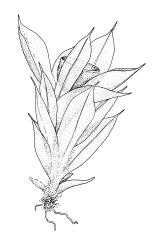Plants small, brown-green to bright green. Stems red-brown or pale, unbranched or rarely forked, to c. 2 mm high, in cross-section with weakly differentiated, firmer-walled cortical layers and a weak central strand, beset below with red-brown or cerise rhizoids that rarely bear ovoid tubers. Leaves erect-spreading to spreading, concave to somewhat keeled, ovate to obovate-spathulate, acute to acuminate-aristate; margins plane and entire; upper lamina cells quite variable, often hexagonal to oblong and frequently with some cells oblate, not differentiated at margins; those in lower portion of lamina more oblong or quadrate and often laxer, sometimes with walls undulate and weakly thickened at corners, a row of yellow-brown cells frequently present at the insertion; alar cells not differentiated. Costa weakly to well developed (rarely ± absent), usually percurrent to excurrent. Axillary hairs present, difficult to observe.
Paroicous, but with antheridia not present in all perichaetia. Setae yellow, 0.2–1.0 mm long, smooth, straight, untwisted; capsules erect, symmetric, ellipsoid to globose (before dehiscence), globose to somewhat pyriform (after dehiscence), c. 1 mm long, operculate, gymnostomous, yellow-brown, strongly and irregularly wrinkled when dry, with a weakly differentiated neck ⅕ or less the length of the capsule; mouth transverse, equal or slightly less than the diameter of capsule; exothecial cells irregularly polygonal, c. 30–50 μm diam., with thin, radially non-cuneate walls, several suboral rows oblate and firmer-walled; operculum plano-convex, not rostrate, falling with a portion of the columella attached, composed of irregularly arranged, thin-walled cells; annulus weakly differentiated, composed of a single row of small, firm-walled, isodiametric to oblong cells, persistent; stomata numerous, superficial or weakly immersed, single-celled. Calyptra broadly mitrate, with a short, stout rostrum, with 8 radial pleats, 8-lobed at base, completely covering the immature capsule and often persisting after dehiscence. Spores ellipsoid, yellow-brown, minutely verrucate and often appearing smooth under light microscope, usually reticulate at maturity, (40–)60–110 μm in greater diam.
A small genus of between one and five species, distributed mainly in Australia, southern Africa, and Spain. Taxa occurring in southern Africa, Australia, and Spain could justifiably be reduced to subspecies within G. acuminatum. Goniomitrium has been traditionally (Brotherus 1924) placed in the Funariaceae. A molecular study by Goffinet & Cox (2000) presented the surprising conclusion that Goniomitrium should be shifted to the Pottiaceae. However, a more recent molecular study (Werner et al. 2007) concluded that Goffinet & Cox used incorrectly determined material in their study, and, using chloroplast DNA (rps4 and trnL-trnF sequences), corroborated the traditional view that Goniomitrium is best placed in the Funariaceae. Further, they concluded that the present genus belongs to a well-supported clade together with the monotypic northern hemisphere Pyramidula Brid., and formally proposed the subfamily Pyramiduloideae to accommodate these two genera.
Goniomitrium and the allied Pyramidula are unique in the Funariaceae in having relatively large (mostly 50–90 µm) spores, which often appear smooth under the light microscope but become reticulate with maturity. The spores are pale to gold-brown in both genera (Fife 1985). Stone (1981) examined Australian Goniomitrium taxa in detail, including their spore morphology, and compared the Australian and Africa taxa.
All species of Goniomitrium occur on soil and probably develop after heavy seasonal rains.
| Category | Number |
|---|---|
| Indigenous (Non-endemic) | 1 |
| Total | 1 |




